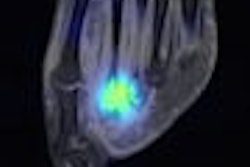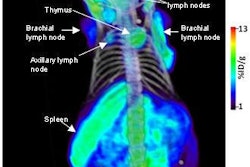NEW ORLEANS - SNM is targeting its own version of the three R's -- regulatory, reimbursement, and research -- in its list of priorities in the coming year.
"To ultimately deliver the best patient care, we have to get promising new agents approved, we have to ensure they are reimbursed appropriately, and we have to continue exploring how they can best be used to help our patients," said incoming SNM president Robert Atcher, Ph.D., on Tuesday at the 2008 SNM annual meeting.
During a joint news conference, outgoing SNM president Dr. Alexander McEwan noted that much of the technology on display at SNM 2008 is the result of research funding from 15 and 20 years ago. "This funding is very important to maintain if we are going to see a comparable level of healthcare improvement in 15 years time," he said.
McEwan also detailed some of the society's accomplishments over the past year, including an 11% increase in SNM membership and the restoration of $17 million in funding for research grants in the U.S. Department of Energy's 2009 budget. The first round of grants has been reviewed and results are pending.
One issue that McEwan said has aggravated the organization during the past year was the temporary shutdown of the Chalk River Laboratories nuclear reactor in Ontario, Canada. The interruption in the supply of medical isotopes created a worldwide shortfall. McEwan estimated that between 20% and 40% of SNM members, particularly clinical labs, were adversely affected by the interruption.
The situation was further aggravated last month, when the Canadian government said it was canceling plans to build two new nuclear reactors dedicated to medical isotopes to replace the aging Chalk River facility.
Atcher said that the Reston, VA-based organization was "appalled by the situation," especially considering that today there is no U.S.-based source for the radiotracers that are used in medical tests to treat breast cancer, heart disease, and other life-threatening conditions.
Isotope production
SNM currently is leading an effort to assess what isotope-producing capabilities, if any, exist at any stage of development within the U.S. "We need to find a short-term and long-term solution to this problem," Atcher added.
To that end, SNM has been in touch with the University of Missouri in Columbia, which has a research program funded by the U.S. Department of Energy's National Nuclear Security Administration to investigate the production of low-enriched uranium to produce molybdenum-99.
There have been discussions about the feasibility of building a new facility at the school to produce the radiotracers. Potentially, Atcher said, such a facility could supply as much as 50% of the U.S.'s demand. The cost to construct, outfit, and secure permits for the facility would be in the range of $40 million, and it would take until 2012 to come online.
In the area of research, SNM currently is developing guidelines to improve the quality and output of clinical trials. One objective is to help researchers qualify for multisite trials, write clinical protocols, and conduct clinical trials in accordance with Good Clinical Practice guidelines.
Clinical trials
"This framework will allow us to work with the pharmaceutical industry to use molecular imaging tools as imaging biomarkers," McEwan said. "We believe this will contribute to speeding up the drug approval process, the identification of the best way of using drugs, patient stratification, and therapeutic decision-making in the future."
The initiative also would make the clinical trial framework available to individual investigators and university researchers, so they can take their discoveries to multicenter trials more rapidly, thus shortening the development of new pharmaceuticals.
The information would be available to pharmaceutical companies to aid in the drug discovery process and speed the approval of indications for new radiotracers.
In addition, SNM hopes the initiative will expand the evidence for the use of FDG in additional indications, such as radiotherapy treatment planning, measuring and monitoring treatment outcome, and stratifying patients for a specific treatment plan.
SNM has formed several working groups to develop the clinical trial business plan by August. McEwan said the framework could be in place by fall.
New opportunities
"We are on the brink of an incredible new opportunity to provide the right patient with the right drug at the right time," Atcher said. "With molecular imaging, doctors can quickly know how effective the treatment is, allowing them to target treatment more accurately and often more successfully. This is the promise of personalized medicine."
Regarding regulatory affairs, Atcher advocated that the U.S. Food and Drug Administration (FDA) hire more scientists and physicians who have the most recent training in nuclear medicine and molecular imaging to assist in the assessment and approval of new imaging agents and technologies. He added that current "persistent barriers" to the approval of new molecular imaging technologies and agents "delay robust clinical trials and FDA review and approval."
The barriers further add to "the delay in reimbursement and clinical acceptance by oncologists and other clinicians, denying the benefit of the technologies to patients with cancer and other diseases," he said.
By Wayne Forrest
AuntMinnie.com staff writer
June 18, 2008
Related Reading
SNM's Images of the Year show molecular imaging's head-to-toe prowess, June 16, 2008
Nuclear medicine must overcome obstacles to flourish in the future, June 15, 2008
SNM explores feasibility of U.S. medical isotope source, May 22, 2008
Canadian government to stop development of Maple reactors, May 16, 2008
New U.S. budget funds nuclear medicine programs, January 14, 2008
Copyright © 2008 AuntMinnie.com




















